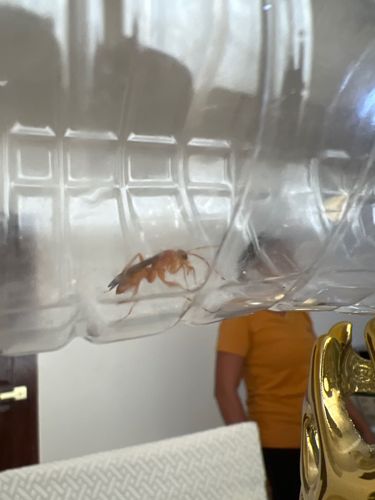Cockroach Wasp, Asian Cockroach Wasp (likely)
Scientific Name: Ampulex compressa (for Emerald Cockroach Wasp, but this appears to be a different species within the family Ampulicidae or broader Sphecidae)
Order & Family: Hymenoptera (Order), Ampulicidae or Sphecidae (Family)
Size: Most cockroach wasps range from 1 to 3 cm (0.4 to 1.2 inches) in length.

Natural Habitat
Typically found in tropical and subtropical regions. They are often associated with human dwellings and gardens where their cockroach prey can be found. The specific species in the image appears to be an indoor inhabitant or wanderer, possibly attracted to lights.
Diet & Feeding
Adult wasps feed on nectar and honeydew. The larvae are parasitic, feeding on paralyzed cockroaches provided by the mother wasp.
Behavior Patterns
Cockroach wasps are known for their unique predatory behavior. The female wasp stings a cockroach twice: first in the thorax to paralyze its front legs, and second in the brain to induce a docile, 'zombie-like' state. She then leads the cockroach to a burrow, lays an egg on it, and seals the burrow. The hatched larva consumes the living cockroach.
Risks & Benefits
Risks: Generally considered harmless to humans, as they are not aggressive and stings are rare, usually only occurring if provoked. The sting is not medically significant. Benefits: They can be considered beneficial in some contexts as a natural biocontrol agent for cockroaches, helping to regulate their populations, particularly in tropical environments.
Identified on: 9/26/2025